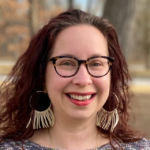The New York State Education Department (NYSED)’s Culturally Responsive-Sustaining Education Framework says “Culturally responsive education is about teaching the students in front of you. To do this requires that one work to get to know their students and develop meaningful relationships.” NYSED’s framework offers this clear guidance. Those of us who do the work of teaching or supporting foundational skills for reading know that a set of instructional materials that offers explicit and systematic instruction and practice is a critical support for this work. With these two important ideas in mind, we set off to learn from and with teachers about the ways in which an orientation to culturally responsive-sustaining education intersects with instructional materials in the early reading classroom.
How better to learn about this intersection than directly from practicing teachers? To do this work, we partnered with colleagues at Teaching Lab to create space for a teacher community of practice. We focused on the Core Knowledge Language Arts skills curriculum, and recruited four teachers to join us in the following goals:
Consider: Explore the relationship and intersectionality of foundational skills and culturally responsive-sustaining education (CRSE), including how materials like Core Knowledge Language Arts support or detract.
Learn: Build a shared understanding of CRSE and its importance within instruction and the classroom.
Act: Bring the ideas and content we explore into your respective classrooms and consider how they can be sustained over time.
Share: Document and share your work with our community of practice.
To begin this work, we sat down with each of our teachers (Bianca Baquerizo, Danielle Goins, Tassia Rosa, and Kareba Williams) to learn about their classroom, their school settings, and the way in which they approached foundational reading and culturally responsive pedagogy. We found that while there was not one shared definition at work across these four different classrooms, the teachers had an orientation towards building a strong class community, listening to and adapting for their students, and monitoring student academic progress. We also found they faced some common challenges, including a concern about students who needed more time and support falling behind due to the pacing of instruction.
We convened our community of progress to learn from one another. We used NYSED’s framework to build a shared understanding of Culturally Responsive-Sustaining Education. The teachers reflected on how their instructional materials both supported and hindered these goals. It was clear that while, at times, bolder moves were needed to adapt instruction, often small tweaks or adjustments at the student and lesson level could allow teachers to make use of the supports the materials offered while making meaningful adaptations. To make these kinds of adaptations concrete, we made use of the concept “Add, Adjust, or Substitute” to name the teacher moves that could support two key areas of the classroom–pursuit of a Welcoming and Affirming Environment, and Inclusive Curriculum and Assessment. Here are some examples of the work done with these goals in mind.
Teaching the foundational skills for reading to our youngest learners is rewarding, challenging, and incredibly important work. Let’s ensure that teachers have instructional materials that support them, and the agency and support they need to plan, execute, and adapt to make these lessons rich and relevant for the unique needs of the children in their classrooms.
















